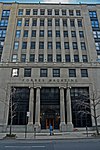The Greenwich Village townhouse explosion occurred on March 6, 1970, in New York, New York, United States. Members of the Weather Underground (Weathermen), an American leftist militant group, were making bombs in the basement of 18 West 11th Street in the Greenwich Village neighborhood, when one of them exploded. The resulting series of three blasts completely destroyed the four-story townhouse and severely damaged those adjacent to it, including the then home of actor Dustin Hoffman and theater critic Mel Gussow. Three Weathermen—Ted Gold, Diana Oughton and Terry Robbins—were killed in the blast, while two survivors, Kathy Boudin and Cathy Wilkerson, were helped out of the wreckage and subsequently fled.Responding firefighters initially believed the blast to have been an accidental gas explosion, but police suspicions were aroused by the two survivors' apparent disappearances, and by that evening other bombs the Weathermen had built were found. They had been meant for several targets: a noncommissioned officers' dance at Fort Dix in South Jersey that night, and the administration building at Columbia University. The unexploded dynamite found in the ruins could have destroyed all the houses on both sides of the block had it detonated in the blast. Robbins and Oughton were in the basement building the bomb intended for Fort Dix, later described as the largest explosive device ever found in Manhattan, when it exploded prematurely; Gold had just returned from running an errand and was killed by the collapse of the building's facade. Boudin and Wilkerson were on the upper floors and survived with only minor injuries. It took nine days of searching to find the explosives and bodies; Oughton and Robbins' were so badly dismembered and mutilated that they had to be identified through dental records.
The two survivors, already facing assault charges in Chicago for their actions during the Weathermen's Days of Rage there the preceding October, were charged with unlawful possession of dynamite. After their bail in the Chicago case was revoked when they failed to show up for trial shortly after the explosion, Boudin and Wilkerson remained fugitives from justice for a decade. Wilkerson voluntarily surrendered in 1980 and served 11 months in prison on the charge. Boudin eventually was apprehended in 1981 and pleaded guilty to felony murder and robbery in the Brink's case in exchange for a sentence of 20 years to life in prison.
Robbins, recalled as an inexperienced bombmaker who refused to take any suggestions that might have improved safety and stuck to the way he had been told to build the bombs, had hoped that the bombings would do serious damage and inflict enough casualties for the Weathermen to be taken seriously by their putative allies in the Black Panthers as revolutionary opponents of the Vietnam War and institutionalized racism, since the group's previous bombings had generally done little more than inconvenience their targets. The self-destructive failure of their plot had the opposite effect: most of the members left, and most support from the greater radical left-wing community evaporated. Those who remained, including Wilkerson, learned more about explosives and bombmaking; their campaign continued for another six years. A new, modernist house similar in appearance was built on the site in 1978; its value has risen into the millions.






